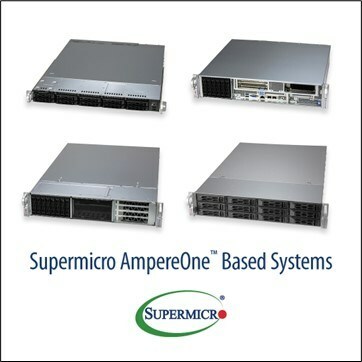Supermicro Adds 192-Core ARM CPU-Based Low Power Servers to Its Broad Range of Workload Optimized Servers and Storage Systems.
Supermicro, Inc. (NASDAQ: SMCI), a Total IT Solution Provider for Cloud, AI/ML, Storage, and 5G/Edge, is announcing several new servers to its already broad application-optimized product line. These new servers incorporate the new AmpereOne™ CPU, with up to 192 single-threaded cores and up to 4TB of memory capacity. Applications such as databases, telco edge, web servers, caching services, media encoding, and video gaming streaming will benefit from increased cores, faster memory access, higher performance per watt, scalable power management, and the new cloud security features. Additionally, Cloud Native microservice-based applications will benefit from lower latencies and power usage.
“Supermicro is expanding our customer choices by introducing these new systems that incorporate the latest high core count CPUs from Ampere Computing,” said Michael McNerney, vice president of Marketing and Security, Supermicro. “With high core counts, predictable latencies, and up to 4TB of memory, users will experience increased performance for various workloads and lower energy use. We continue to design and deliver a range of environmentally friendly servers that give customers a competitive advantage for various applications.”
As part of the ARM ecosystem, these new servers incorporate OpenBMC for industry-standard server management, which enables the integration of these new Supermicro servers into on-prem and hyperscale data centers.
Supermicro’s ARM-based MegaDC servers are an innovative extension to the Ampere® Altra® CPU, ranging from 32 to 128 cores, and with AmpereOne™, with up to 192 cores. The AmpereOne ™ based servers include PCIe 5.0 and DDR5, as well as more memory and I/O bandwidth with a significant performance enhancement to the previous generation systems, resulting in faster overall application performance. Customers can leverage Supermicro’s Building Block Solution architecture to support various application workload requirements for more memory bandwidth and capacity, more PCIe expansion slots, and CPU performance with less power consumption.

